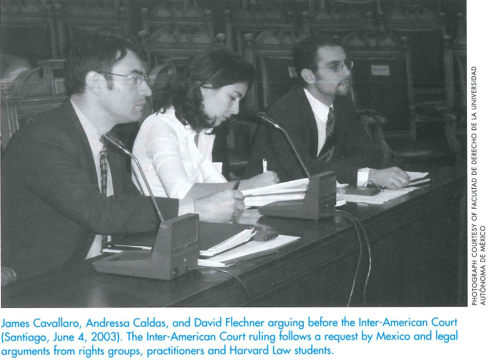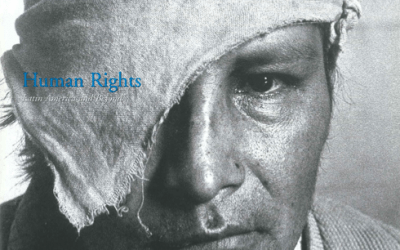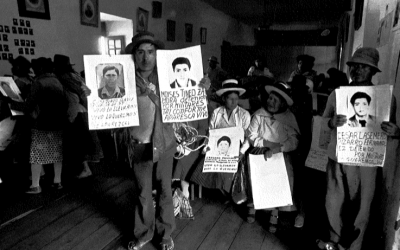Inter-American Court
Addressing Migrant Laborers’ Human Rights

On September 18, 2003, the Inter-American Court issued an historic judgment expanding the scope of protection of labor rights of migrant workers in the Americas. The decision is the most recent in a growing body of international law recognizing that fundamental labor guarantees may not be arbitrarily denied to persons solely on the basis of their migratory status. After months of reviewing briefs and hearing arguments—including those of a coalition of Harvard students and lecturers—the Inter-American Court ruled that migrant laborers’ were entitled to host of protections afforded other workers under international law.
BACKGROUND
Over the course of the past two decades, migration within the Americas has radically changed the face of much of the Western Hemisphere. In the 1980s, civil wars in Central America led hundreds of thousands to leave their homes in Guatemala, El Salvador and Nicaragua and head north to neighboring Central American states, as well as to Mexico, the United States and Canada. Scores of thousands have fled the seemingly endless civil war in Colombia in virtually every direction, leading to the presence of Colombian immigrant communities from Canada to Argentina.
Although wars throughout the continent have largely ended, with the notable exception of Colombia, migrants have continued to cross borders in record numbers in the last decade. Natural disasters, economic stagnation, high levels of unemployment tied to endemic corruption and the adoption of neoliberal structural adjustment policies have led to high unemployment levels. Although many countries have received large numbers of immigrants over the past two decades, the United States stands out as the nation receiving the largest number of immigrants. According to the U.S. Census Bureau, there were more than 31 million immigrants—at least 11 % of the overall population—living in the United States in 2000. The Bureau estimates that 8.2 million of those immigrants are undocumented. Almost 60 percent of all unauthorized migrants are Mexican; approximately twenty percent more are Central American; the remaining twenty percent come from other regions (including South America). The U.S.’s undocumented immigrant population is thus overwhelmingly Latino.
The wave of immigration in the past two decades, together with developments in public international law and practice, have rendered migrant labor rights in the Americas a major human rights issue. In every major immigrant-receiving country in the Americas, migrant workers are disproportionately represented in low-paying, high-risk jobs. Non-payment of wages, on-the-job discrimination, inhumane work conditions, and anti-union repression are, unfortunately, routine. Yet, until relatively recently, human rights groups in the Americas have focused on civil and political, rather than economic, social and cultural rights, particularly abuses committed in the course of political conflicts, and have thus failed to place sufficient attention to the labor rights of migrants.
The international community has increasingly focused on the rights of migrant laborers. For example, on July 1, 2003, the United Nations International Convention on the Protection of the Rights of All Migrant Workers and Members of Their Families entered into force. Fittingly it was a Latin American state—Guatemala—that provided the critical twentieth ratification.
ONE STEP FORWARD, TWO STEPS BACK?
Yet formal, international acknowledgement of the importance of migrant labor rights has not corresponded with the development and implementation of more receptive state policies and practices. On March 27, 2002, the United State Supreme Court issued its decision in Hoffman Plastic Compounds v. National Labor Relations Board. In that case, the National Labor Relations Board (NLRB) had ordered an employer to issue backpay to a laborer who had been wrongfully discharged as a direct consequence of his engagement in lawfully protecting union organizing. During the course of the NLRB hearing process the employee admitted that he had been in the country illegally at the time of his dismissal and proffered false identification to his employer. On these facts, the United States Supreme Court held that the National Labor Relations Board (NLRB) could not order an award of backpay. In a 5-4 decision, the Court reasoned that in issuing a backpay award to an undocumented worker, the NLRB had impermissibly undermined federal policies aimed at discouraging federal immigration.
On May 10, less than two months after the Hoffman decision, the Government of Mexico requested that the Inter-American Court of Human Rights issue an advisory opinion on the intersection of migrant labor rights and national immigration policies. The Mexican government posed four detailed questions to the Court. Five states filed briefs with the Court, as did eleven non-governmental organizations, attorneys and law schools from throughout the Americas. One of these groups was a coalition from Harvard, led by the Harvard Law School Advocates for Human Rights, with the guidance of the Human Rights Program.
THE JUNE 4 SESSION
After hearing the arguments of State and the Inter-American Commission, the Court scheduled hearings for amicuspetitioners for June 4. At that session, the rights and university groups present urged the Court to issue a broad ruling, emphasizing that the principle of non-discrimination should only be limited where vital state interests are at stake. Their arguments focused on the vulnerability of migrant workers, particularly on those without documents, and the need for the Court to establish a clear hierarchy of norms in which freedom from discrimination would trump state immigration policy.
Another key issue raised at the June session concerned the extent to which state law and practice in the Americas, in fact, discriminated against migrant workers. On this point, the brief of the Harvard coalition provided analysis of the practice of six countries in the hemisphere that receive large numbers of immigrants: the United States, Mexico, Chile, Argentina, the Dominican Republic, and Brazil. At oral argument, other amicus petitioners corroborated the Harvard coalition’s testimony on the United States, Argentina and Chile.
THE RULING AND THE FUTURE OF IMMIGRANT RIGHTS IN THE AMERICAS
In late September, the Inter-American Court issued its decision in the case, drawing on the arguments presented by the responding States, the Commission and amicus petitioners. It noted, as the Harvard submission had emphasized, that migrant laborers are subjected to a wide range of abuses, in law and practice. In an historic advance, the Court held non-discrimination to be jus cogens, a peremptory or highest order norm in international law. In light of that, the Court ruled that States could not legitimately restrict or deny, based on migratory status, those rights acquired by virtue of an employment relationship.
While an important advance, the opinion in the case is no doubt part of a longer process. If past history in the area is any guide, the Inter-American Court’s legal recognition of the labor rights of migrants in the Americas will be but the first step in a long struggle to ensure dignified treatment for millions of migrant workers throughout the hemisphere.
The full text of the Inter-American Court decision (as well as the four concurring opinions) is available at http://www.corteidh.or.cr/index.html.
Fall 2003, Volume III, Number 1
James L. Cavallaro, Harvard College ’84, is the Associate Director of the Human Rights Program and Lecturer on Law at Harvard Law School, as well as a Member of the Policy Committee of the David Rockefeller Center for Human Rights.
Daniel A. Schlanger, HLS, ’04, is the President of Harvard Law Student Advocates for Human Rights.
Related Articles
Human Rights: Editor’s Letter
During the day, I edit story after story on human rights for the Fall issue of ReVista. During the evening, I work on my biography of Irma Flaquer, a courageous Guatemalan journalist who was…
ONGs en América Latina y los derechos humanos
Las ONG ofrecen mil modos de recordar la dignidad humana a los gobiernos y las sociedades. Las dos experiencias que esbozo en esta nota reflejan algunas de las estrategias asumidas por…
Peru’s Human Rights Coordinating Committee
The human rights abuses that devastated Peru from the early 1980s to the mid 1990s are once again an issue of debate in that country with the release of the Peruvian Truth and Reconciliation’s…




